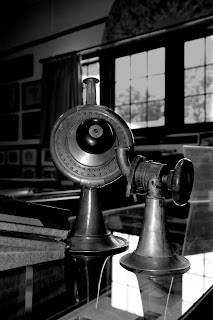 |
| James Bazin's Spectacles - in the collection of the Canton Historical Society |
James A. Bazin: A glimpse of history through thin, gold frames
On a recent historical tour of Canton for residents at Orchard Cove, I was extolling all of the amazing oddities that made Canton, well, uniquely Canton. And after rattling off a list of firsts in America that are connected to Canton, one of the passengers gave me a look that suggested she did not quite believe my facts. It was when our bus passed the home in Ponkapoag owned by James A. Bazin, and I recited the fact that Bazin invented the first reed instrument in America. The Bazin house still stands to the left of the driveway at the entrance to the Ponkapoag Golf Course.
Bazin (pronounced Bay-Zahn) is perhaps one of Canton’s most interesting citizens. The photo is of his spectacles, and it made me think of all the amazing things that Bazin saw through his eyes and what he produced while a citizen of Canton. History is made up of touch points, and holding his glasses (which are in the collection of the Canton Historical Society), you can feel the pulse of history through the thin gold frames.
James Amireaux Bazin was born in Boston in 1798. He was the fifth of ten children born to Jean Bazin and Jeanne (Amireaux) Bazin. Jean, a watchmaker, was a French Huguenot who came to Boston in 1788 from Helier, on the Isle of Jersey — a small town off the coast of France. In 1812, when Bazin was 14, the family moved to Canton and settled in Ponkapoag. The family “hired a small house known as the Sherman House, built by John Wentworth in 1805.” This house was still standing in 1922 on Sassamon Street. It appears that the education that Bazin received was extremely supportive of his early interests, which included astronomy, mathematics, as well as the fine arts.
We know much of Bazin’s life because he was one of the most highly esteemed citizens in Canton. Also, more than 100 personal items are in the collection of the local historical society and each one is a connection to his time and place in our town. The items are both plain and complicated: a small serving dish, a china platter, a teapot and pewter serving pieces — all connected to the fantastic — an astronomical model of the universe, magnifying eyeglasses, a walnut rotary pump. And then there are the instruments, perhaps Bazin’s finest contributions to the creation of early reed instruments in America. The range again is wonderfully collected: a small harp, two organ pianofortes (from 1853), and several reed-based lap organs alongside two reed trumpets of fantastic invention.
Bazin came to examine a simple free-reed instrument when he was 23 years old. A group of men brought him a broken pitch pipe and asked him to repair it. Bazin made the repair but also created a new invention, which became a sliding brass pitch pipe that could be adjusted along a series of pitches from c” to d’”. From this small invention he began making several variations on the theme and eventually moved to reed trumpets, which he invented in 1824. For many years his trumpet accompanied the choir at the Unitarian Church in Canton Corner and reputedly it could be heard “a mile away.” In 1831 Bazin invented a harmonica. In fact, Bazin had only read about the harmonica invented in Germany, so it is likely that indeed this was the first reed harmonica in America.
 |
| Bazin's Inventions |
 |
| James Amireaux Bazin by R. C. Steadman |
A true renaissance man, Bazin maintained an impressive garden, sang in the church choir, and was a supporter of the fledgling Canton Public Library, donating several ancient French and English books to the early collection. In 1840 he became town clerk, a position he held for nine years. Bazin’s portrait, drawn by R. C. Steadman, hangs in the office along the left-hand wall as you stand at the counter. When he died in 1883 at age 85, his obituary read, “His long life had been a comfort to himself and a credit to his adopted town and fellow citizens.”
The family headstone is a massive granite ashlar in Canton Corner Cemetery. But the best reminders of Bazin’s life are the musical instruments that were born from his invention and let us see through his eyes the genius of Bazin.
This story appeared in the Canton Citizen on November 18, 2010.
This story appeared in the Canton Citizen on November 18, 2010.
No comments:
Post a Comment